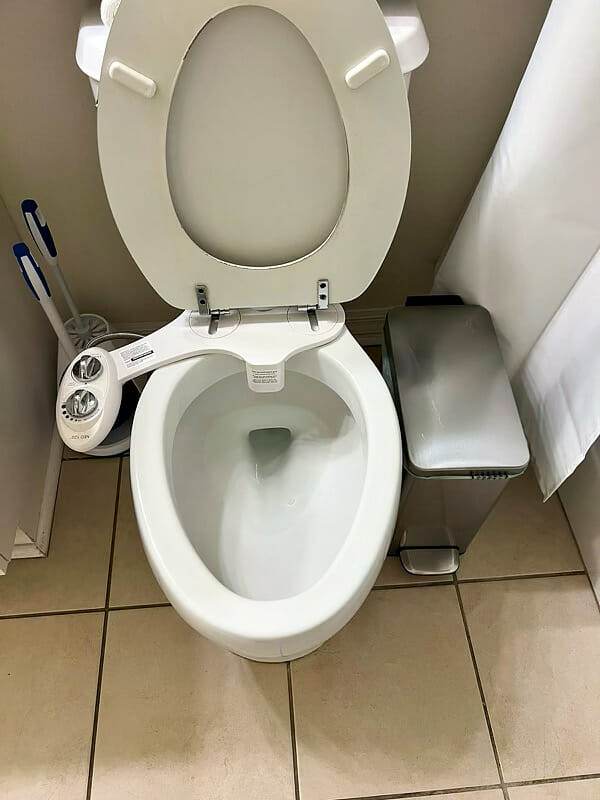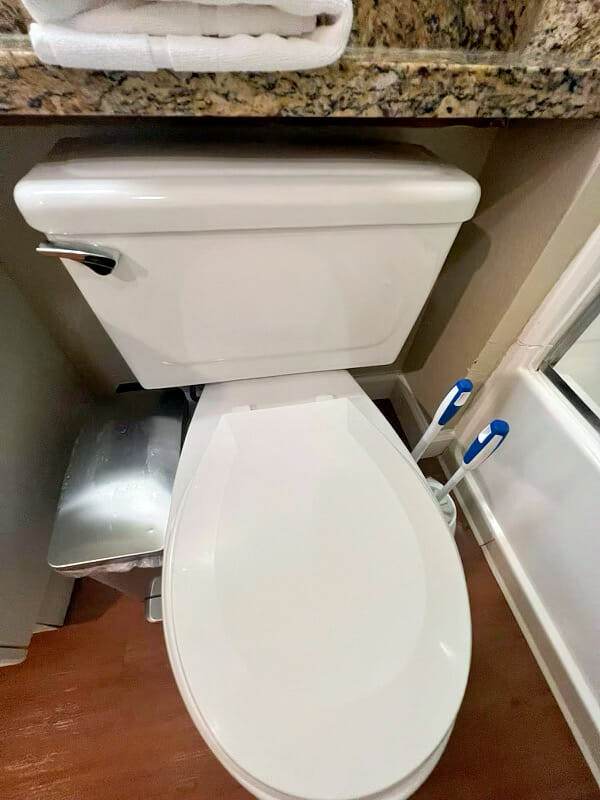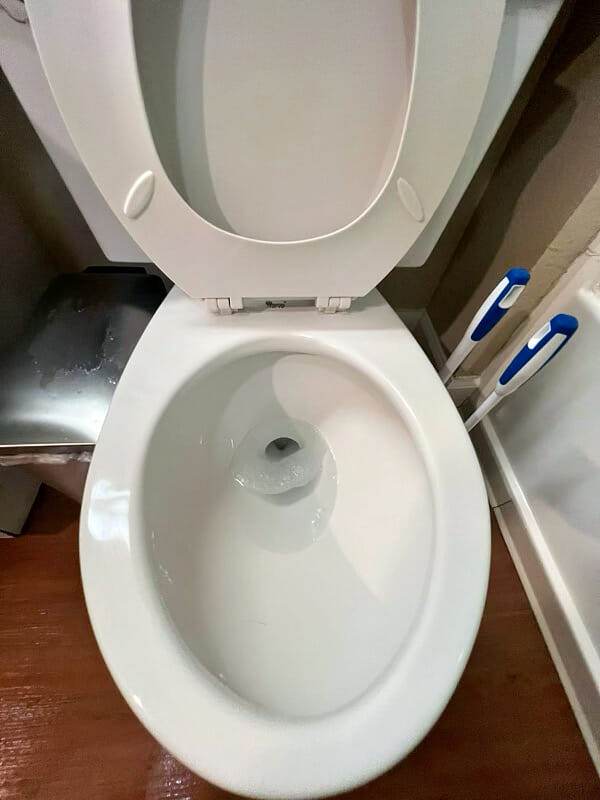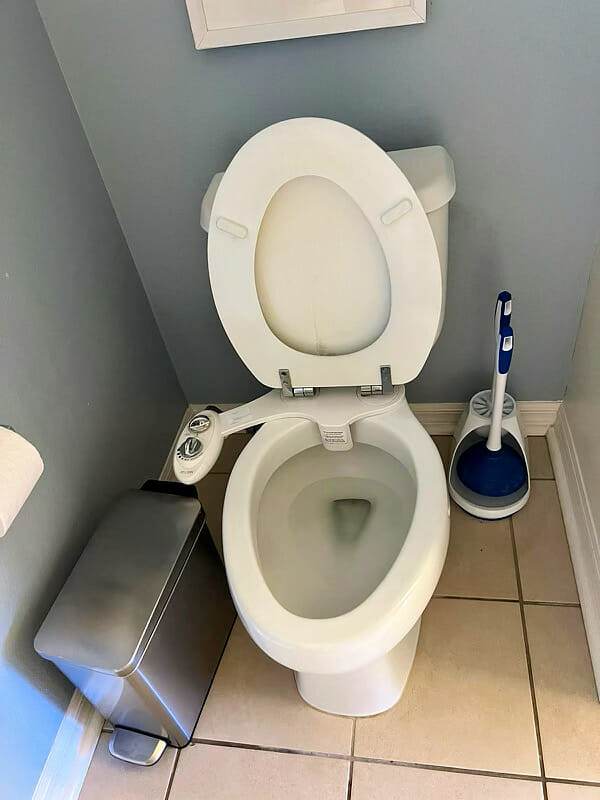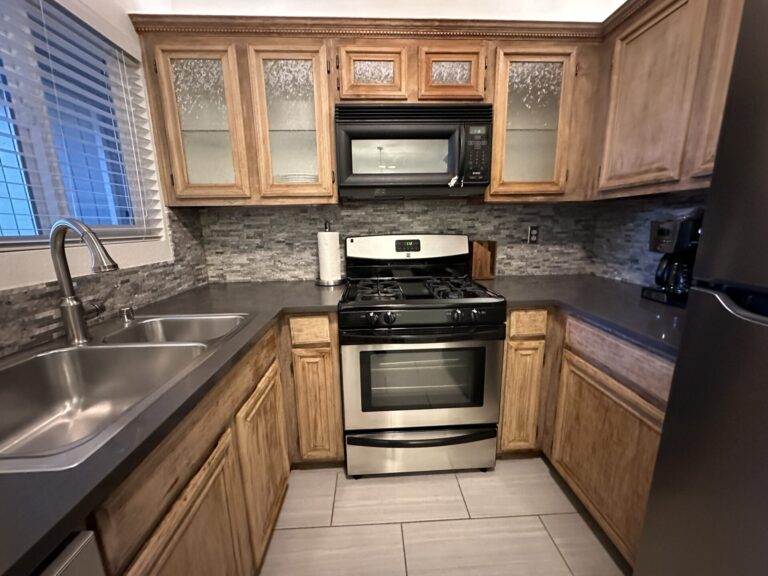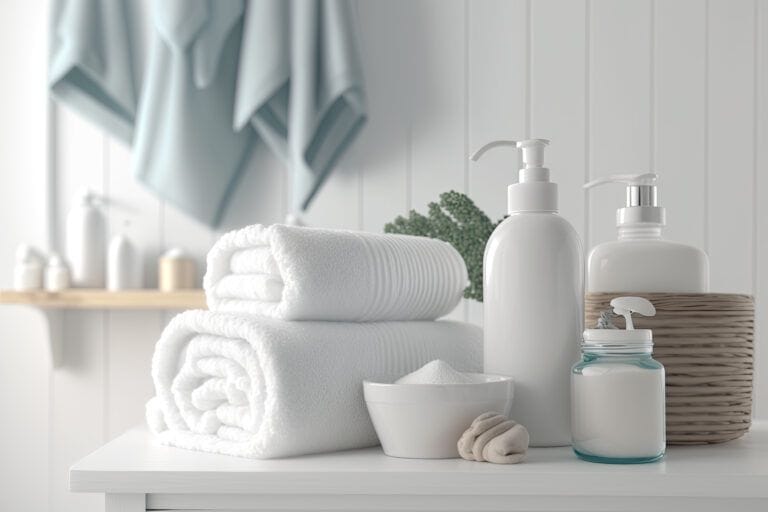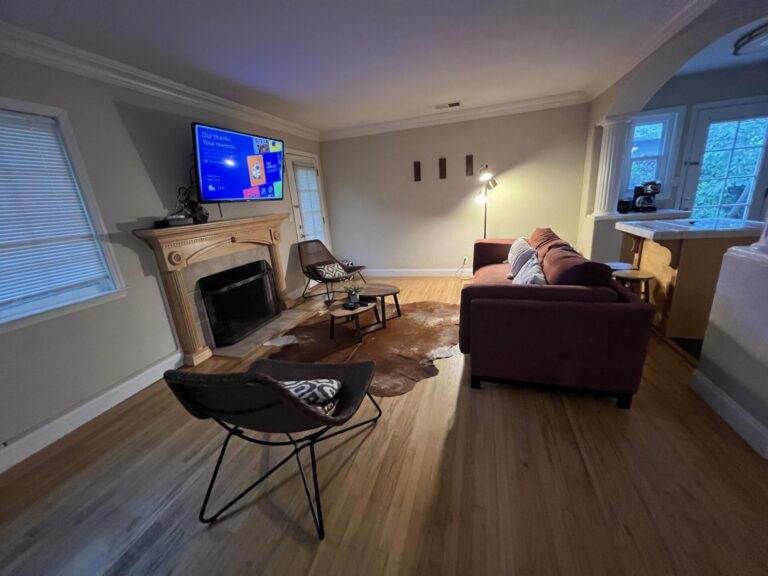How can I remove stains from my toilet?
Here are some steps you can follow to remove stains from your toilet:
- Gather Cleaning Supplies: You’ll need a toilet brush, gloves, and a toilet bowl cleaner. You can use a commercial cleaner or a homemade solution such as vinegar and baking soda.
- Apply the Cleaner: Squirt the toilet bowl cleaner under the rim of the toilet and let it slide down the sides into the water. If you’re using vinegar and baking soda, pour one cup of vinegar into the bowl followed by one cup of baking soda.
- Wait for It to Work: Allow the cleaner to sit for at least 15 minutes. This gives it time to break down limescale, rust, and other stains.
- Scrub with Toilet Brush: After waiting, grab your toilet brush and start scrubbing. Pay extra attention to any stubborn stains, especially under the rim and in the very bottom of the bowl where water flows out during flushing.
- Flush: Once you’ve scrubbed thoroughly, flush your toilet to wash away all remnants of dirt and cleaning solution.
- Repeat if Necessary: If there are still stains left after one round of cleaning, repeat these steps until your toilet shines again.
Remember to always wear gloves while cleaning toilets for hygiene purposes.
What are the common causes of toilet stains?
Common causes of tough stains in your toilet bowl can vary, but they often have a few things in common. Here is an overview:
- Hard water and mineral deposits: This is the most frequent cause of stubborn toilet bowl stains. Hard water has a high content of minerals like magnesium and calcium. When the water evaporates, it leaves these minerals behind, causing a buildup that results in yellow or brownish stains.
- Rust Stains: These are usually caused by high iron content in your water supply. Rust stains are typically reddish-brown and can be difficult to remove.
- Green or Brown Stains: The presence of green or brown stains can imply mold or mildew. These fungi thrive in moist environments like your bathroom, especially if you don’t clean regularly.
- Copper Stains: If you notice greenish-blue stains, it could be due to the presence of copper in your water supply which reacts with the porcelain.

To remove these stains, you’ll need different strategies depending on the type of stain. A variety of cleaning products and home remedies are available to remove yellow stains, rust marks and other residues from hard water and mineral deposits.
What are some effective ways to remove toilet stains?
Here are some effective ways to remove toilet stains:
- Flush the Toilet: Always start by flushing your toilet to ensure you’re working with a clean surface. Be sure to clean the toilet seat and place it up.
- Use a Toilet Bowl Cleaner: Apply a good amount of toilet bowl cleaner around the inside rim of your toilet bowl so it can work its way down, covering the entire bowl.
- Let it Sit: Allow the cleaner to sit for about 15-20 minutes. This will give it enough time to break down the stains.
- Use a Toilet Brush: After letting the cleaner sit, use a toilet brush to scrub away the loosened stains. Make sure to reach all areas, especially under the rim and any visible stained spots.
- Pumice Stone Method: If you still notice stubborn stains after using standard methods, you may use a pumice stone. Wet both the pumice stone and toilet before gently rubbing on the stain. Be careful not to scrub too hard as it can potentially scratch your toilet bowl.
- Flush Again: Finally, flush your toilet again to wash away any residue or loosened stains.
Remember, regular cleaning is key in preventing build-up of stubborn stains.
How can vinegar and baking soda help remove toilet stains?
Here’s how you can use white vinegar and baking soda to clean your toilet stains:
- Empty the Toilet Bowl: Start by emptying the toilet bowl as much as possible. You can do this by turning off the water supply and then flushing the toilet until it’s mostly drained.
- Pour Vinegar into the Toilet Bowl: Pour a quarter of a cup or up to half a cup of white vinegar into the toilet bowl. Make sure to distribute it evenly around, not forgetting under the rim.
- Add Baking Soda: After pouring in the vinegar, sprinkle about one cup of baking soda around your toilet bowl, again focusing on even distribution.
- Add More Vinegar: Pour another one to two cups of white vinegar into the bowl over the baking soda. The mixture will start fizzing, which helps remove tough stains.
- Let it Sit: Allow this mixture to sit in your toilet for approximately 10-15 minutes.
- Scrub with Toilet Brush: Using a good quality toilet brush, scrub around the entire inside of the bowl including under the rim where hard water stains are usually prevalent.
- Flush Your Toilet: Once you’ve thoroughly scrubbed all areas of your toilet bowl, turn on your water supply again (if you had turned it off) and flush your toilet.
This method is an effective way to clean your toilet using natural ingredients that are safe for both you and for sewer systems.
What is the role of a pumice stone in cleaning stained toilets?
A pumice stone is an effective tool for cleaning stained toilets. It’s especially useful in removing stubborn mineral stains that often form due to hard water.
Ways to Remove Mineral Stains
Mineral stains are tough deposits left behind by minerals present in your water. They can be unsightly and difficult to remove with normal cleaning products. Here is how you can use a pumice stone:
- Soak the pumice stone in warm water. The stone needs to be wet to prevent scratches on the porcelain surface of the toilet.
- Gently scrub at the stain with the wet pumice stone. Start with light pressure and increase it if necessary.
- Rinse the area frequently to wash away loose debris and check your progress.
Clean Toilet Stains
Just like mineral stains, other types of toilet stains like mold, mildew, or even rust can also be tackled using a pumice stone:
- Again, soak the pumice stone in warm water before starting.
- Scrub at the affected areas gently but firmly until the stain disappears.
- Make sure to rinse well afterward.
Learn How to Clean Stubborn Toilet Stains
For extra-stubborn stains that resist initial efforts, persistence is key:
- Multiple treatments may be necessary over several days.
- You might need to leave some clean water sitting in the bowl for a few hours to soften up hard deposits before scrubbing them again with a soaked pumice stone.
The abrasive nature of a pumice stone helps it eat away at those stubborn toilet stains without damaging your porcelain when used correctly – always wetting it first and applying gentle pressure while scrubbing.
Are there any specific products or cleaners that can help with stubborn toilet stains?
Dealing with pesky stains in your toilet can be a real chore. Here are some specific products and cleaners that can help:
- Lysol Toilet Cleaner: Recognized for its powerful cleaning capabilities, Lysol works magic on stubborn toilet stains. It kills 99.9% of viruses & bacteria while leaving the toilet bowl sparkling clean.
- Zep Toilet Cleaner: This professional-grade cleaner boasts an acidic formula that effectively tackles hard water stains, rust, mineral deposits, and other tough spots in your toilet.
- Vinegar and Baking Soda Solution: A more natural alternative is to use a combination of vinegar and baking soda. Pour a cup of vinegar into the toilet bowl, followed by sprinkling baking soda over it. Let this mixture sit for about 15 minutes before scrubbing with a brush. It’s an effective, eco-friendly solution to eliminate grime and stains.
Remember to always wear gloves when handling these cleaning agents to protect your skin from any harm! Happy Cleaning!
What are some effective methods to remove mineral stains from a toilet bowl?
Wondering how to clean the stains from your toilet bowl? Here are several effective methods to remove mineral stains from a toilet bowl:
- Using a Vinegar Solution Around the Bowl:
- First, empty the water from the toilet bowl to allow the vinegar to reach the stains.
- Then pour 2 cups of vinegar into the toilet bowl.
- Let it sit for about 30 minutes.
- After that, scrub the toilet away the stains with a toilet brush.
- Using Vinegar & Baking Soda:
- First, you need to get rid of the toilet water by either using a cup or turning off the water valve and flushing.
- Sprinkle baking soda around the inside of your toilet bowl and then pour in some vinegar. It will start fizzing immediately.
- Let this mixture sit in your toilet for about 30 minutes.
- Scrub away at the stain with your toilet brush.
- Using Commercial Cleaners:
- Products like Mr.Clean Toilet Cleaner can be quite effective as they are specifically manufactured for cleaning toilets.
- Apply it as per instructions provided on product packaging and then scrub with a brush.
- Pumice Stone Cleaning Method:
- Make sure to wet both, your pumice stone and your toilet, before starting as a dry pumice stone might scratch your porcelain surface.
- Scrub gently at stubborn mineral deposits until they begin to break down and disappear.
Each method has its strengths so try each one until you find what works best for you. Remember to always wear gloves when cleaning toilets for hygienic reasons!
What are mineral stains and why are they difficult to remove?
Mineral stains are discolorations that occur on various surfaces due to the deposition of minerals from hard water. They often appear as white, chalky residues or may have color variations (like green, blue, brown) depending on the specific mineral content in the water such as iron, copper, calcium, magnesium.
These stains are usually difficult to remove for several reasons:
- Bonding Strength: Mineral deposits bond strongly with most surfaces over time, which makes them tough to scrub off.
- Reactivity: Some mineral substances like lime scale (calcium and magnesium salts) can react with soap and detergents forming a scum which is even more difficult to clean.
- Persistence: Even after cleaning off visible stains, microscopic levels of minerals might persist on the surface that subsequently attract more minerals from the water leading to quick re-staining.
- Porosity of Surface: On porous materials like certain types of stone and tile, the minerals can penetrate into the pores creating deep-set stains that are particularly hard to eliminate.
Removing these mineral stains often requires special cleaning agents formulated to break down mineral compounds. Vinegar and citric acid are commonly used due to their natural acidity which helps dissolve mineral deposits. However, they must be used carefully as they can also etch or damage some surfaces. Professional help might be needed for severe staining or delicate materials.
How can vinegar and baking soda combination be used to remove mineral stains?
Here’s a simple step-by-step guide on how to use vinegar and baking soda to remove mineral stains, including those from your toilet:
- Empty the toilet bowl or the area you want to clean of as much water as possible.
- Sprinkle 1 cup of baking soda around the inside of the toilet bowl, making sure to cover the mineral stains.
- Pour 2 cups of white vinegar into the bowl. The baking soda and vinegar will start fizzing immediately.
- Let this mixture sit in the toilet bowl for about 15-30 minutes.
- With a scrub brush, scrub the stains gently till they disappear.
- Flush the toilet to rinse.
Remember that stubborn stains may need more than one treatment or longer soaking times.
This method can be used for other areas with mineral deposit buildup too, just adjust quantities keeping in mind that you should maintain a 2:1 ratio of vinegar to baking soda.
Is there a specific technique to remove mineral stains using vinegar and baking soda?
Yes, there is a specific technique to remove mineral stains in your toilet originating from hard water using vinegar and baking soda. Here’s how you can get your porcelain throne sparkling clean with these household items:
- Empty the Bowl: First, you’ll need to empty the toilet bowl of water. You can do this by turning off the water supply and flushing the toilet until most of the water is gone.
- Apply Vinegar: Pour enough white vinegar into the toilet bowl to cover the mineral stains. Let it sit for about an hour so that vinegar can loosen up the hard water deposits.
- Add Baking Soda: After an hour has passed, sprinkle baking soda all over the stained areas.
- Scrub: Use a toilet brush or pumice stone to scrub away at the mineral deposits. The combination of vinegar and baking soda should make this process easier as they work together to break down the stains.
- Final Rinse: Once you’ve thoroughly scrubbed away at all visible stains, turn back on your water supply and flush your toilet a few times until it’s clear.
- Repeat If Necessary: If any stubborn stains remain, repeat this process until your porcelain throne is gleaming once more.
Remember, always use gloves when cleaning a toilet to protect your hands from germs and harsh cleaning substances.
Are there any alternative methods or cleaners to remove mineral stains?
Absolutely, there are several methods you can use to clean mineral stains from your toilet or other surfaces. Here are a few you might consider:
- Vinegar: This is an all-natural way to remove mineral stains. Simply pour some vinegar into the toilet or spray it onto the stain, let it sit for about 10 minutes, then scrub with a toilet brush.
- Baking Soda and Vinegar: Mix equal parts baking soda and vinegar to create a cleaning paste. Apply this to the stain and let it sit for 15-20 minutes before you start to clean the bowl followed by scrubbing away.
- Borax: This powder is great for tougher stains for your toilet cleaning. Sprinkle some Borax on the stained area, let it sit for a while, then scrub with a stiff brush.
- Lemon Juice and Salt: For smaller surface stains, try applying a mixture of lemon juice and salt. The acidity of the lemon juice helps break down the minerals while the salt acts as an abrasive.
- Commercial Cleaners: If natural methods aren’t working, there are plenty of commercial cleaners on the market specifically designed to combat mineral buildup and eat away at the stains.
Remember always to carefully follow instructions when using any cleaning product or method.
Should I consider professional help to remove mineral stains from my toilet bowl?
Yes, you might consider seeking professional help to remove stains caused by mineral stains from your toilet bowl. This is particularly beneficial if the stains are stubborn and hard to eliminate with traditional cleaning methods.
For regular maintenance and minor stains, here’s what you can do:
- Keep your toilet clean: Regularly scrubbing your toilet may help prevent build-up of mineral deposits.
- Get rid of toilets stains with your brush: Using a stiff-bristled brush, scrub the bowl thoroughly. You can also use a pumice stone for stubborn stains.
However, if these methods don’t work or if the task seems too demanding, it could be beneficial to hire professionals like Master Clean Service Bay Area. They have specialized equipment and effective cleaning solutions that can handle even the toughest of mineral stains.
Remember that investing in professional cleaning services not only helps maintain cleanliness but also prolongs the life of your fixtures by removing damaging elements like rust and mineral buildup.
How to clean a very stained toilet?
Cleaning a heavily stained toilet might seem like a daunting task, but don’t worry. Here are the steps you need to follow:
- Empty the bowl: Turn off the water supply to your toilet. Then, flush the toilet to drain out most of the water from the bowl.
- Apply cleaning solution: Use a commercial toilet cleaner or make your own by mixing equal parts vinegar and baking soda. Apply this solution liberally on all stained areas inside the bowl.
- Let it soak: Allow the cleaning solution to sit and work on the stains for at least 15-30 minutes, or as long as overnight for tougher stains.
- Scrub with a brush: Use a toilet cleaning brush to scrub away at the stains. Make sure you reach into all corners and under the rim.
- Flush and rinse: After you have thoroughly scrubbed every part of your toilet, turn on your water supply again, then flush to rinse out any residual cleaner.
- Repeat if necessary: If there are still visible stains after carrying out these steps, repeat them until your toilet is as clean as you would like it to be.
Remember always wear gloves and ventilate your bathroom while doing this process! It’s also important not to mix different types of cleaners due to potential chemical reactions that could pose a safety hazard.
What are some common methods to clean a heavily stained toilet?
Here are some methods to clean a heavily stained toilet:
- Baking Soda and Vinegar: Apply baking soda all around the toilet bowl with vinegar. Allow it to fizz for about 10 minutes before scrubbing with a toilet brush. For best results empty the water in the toilet.
- Coca Cola: Pour Coca Cola around the rim so that it flows over the stains in the toilet bowl. Let it sit for at least an hour before scrubbing clean with a toilet brush.
- Bleach and Warm Water: Mix bleach with warm water and pour it into the bowl, let it sit for a while then scrub with a toilet brush. You could also apply on the surface of your toilet and behind the toilet.
- Hydrogen Peroxide: Spray hydrogen peroxide on the stains and let it sit for 30 minutes, then use a toilet brush to scrub away the stains. For best resylts empty bowl.
- Commercial Cleaners: There are many commercial products available specifically designed for cleaning toilets such as Lysol or Clorox Toilet Bowl cleaners.
Remember to always wear gloves while cleaning toilets to protect your skin from harsh chemicals.
How can I effectively use baking soda to clean a very stained toilet?
To effectively use baking soda for cleaning a highly stained toilet, you can follow these steps:
- Flush Your Toilet: Start by flushing your toilet to wet the sides of the bowl.
- Sprinkle Baking Soda: Generously sprinkle baking soda onto the inside of your toilet bowl. Aim to cover every stain with a layer of baking soda.
- Leave to Soak: Let it sit for around 15-20 minutes. The baking soda will start to break down the stains during this time.
- Scrub with Toilet Brush: After soaking, scrub your toilet bowl using a toilet brush. Pay special attention to any remaining stains and hard-to-reach areas.
- Use Vinegar For Stubborn Stains: If some stains are still visible, spray or pour vinegar on them directly and let it sit for another 10-15 minutes before scrubbing again.
- Flush Again: To finish, flush your toilet again to wash away all residue of the baking soda and vinegar.
Remember that while this method is effective for regular maintenance and mild staining, heavily stained toilets might require stronger cleaning products or professional cleaning services.
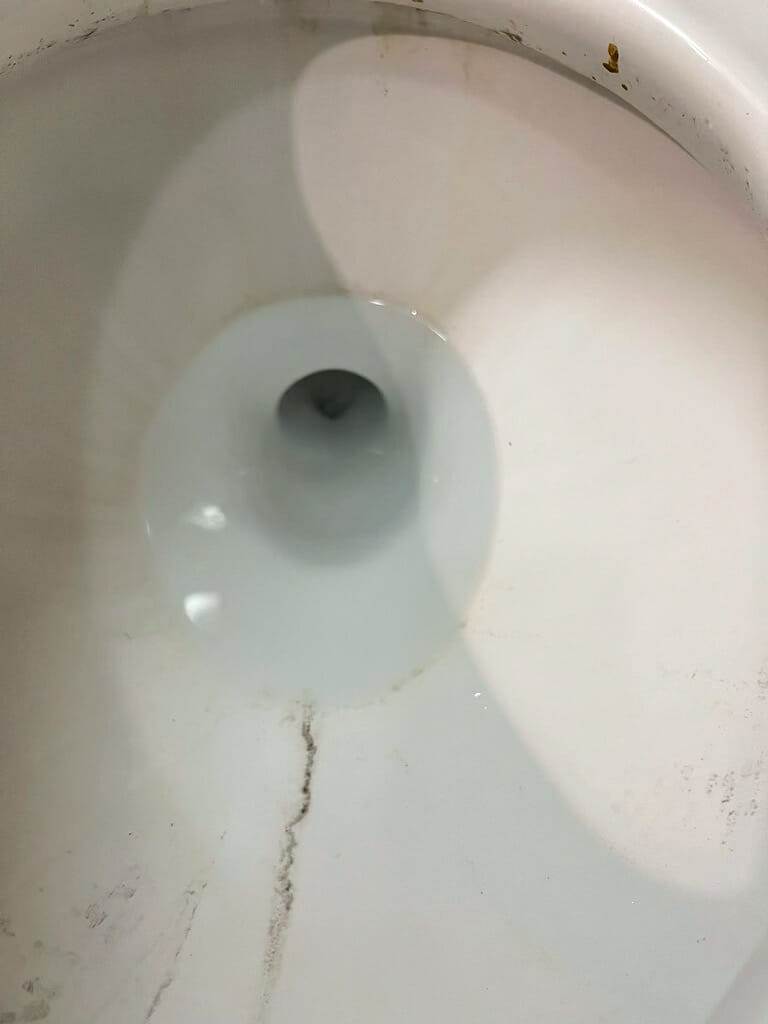
What precautions should be taken while using harsh cleaners on a stained toilet?
When using harsh cleaners to clean a stained toilet, it’s crucial to follow these precautions for your health and safety:
- Always wear protective gear: This includes gloves and glasses to prevent any contact with the skin or eyes.
- Ensure good ventilation: Open windows and doors, turn on fans, or take breaks frequently if you start to feel dizzy or nauseous.
- Avoid mixing different cleaners: Different chemicals may react negatively when mixed together, possibly releasing harmful gases.
- Follow the instructions on the label: Different cleaning products have different instructions. Make sure you’re using the product as intended.
- Keep out of reach of children and pets: Ensure that they are in a safe area away from where you’re working.
- Store cleaning supplies properly after use: They should be stored in an area where kids and pets cannot reach them.
Remember, your safety always comes first!
What are some tips to prevent toilets from getting heavily stained?
Here are some tips to prevent your toilet from getting heavily stained:
- Regular Cleaning: Clean your toilet at least once a week. Use a thick bleach or a specialized toilet cleaner and let it sit for a couple of minutes before scrubbing with the toilet brush.
- Use Toilet Bowl Cleaner Tablets: These tablets are dropped into the tank of the toilet. They slowly dissolve over time, continuously cleaning and preventing stains each time you flush.
- Avoid Harsh Chemicals: Some bathroom cleaners contain harsh chemicals that can damage the porcelain, making it more susceptible to staining. Always look for non-abrasive cleaners that are safe for porcelain surfaces.
- Use a Pumice Stone: For stubborn stains, wet a pumice stone and gently rub it on the stain. Be careful not to scratch the porcelain surface.
- Maintain Water Quality: Hard water can cause mineral build-up and stains in your toilet bowl. Consider using a water softener if you have hard water in your home.
- Preventative Measures: If you’re not going to be using a particular toilet for an extended period (like in a guest bathroom), consider shutting off the water supply and draining the tank and bowl to prevent stagnant water stains.
Remember, hiring professionals like Master Clean Service Bay Area might save you time due to their expertise and routine cleaning schedules.
Can regular maintenance help in keeping the toilet free from stains?
What are the best ways to remove hard water stains from a toilet bowl?
Yes, regular maintenance can certainly help in keeping the toilet free from stains. Here are some tips for it:
- Clean your toilet bowl at least once a week using a good quality toilet cleaner.
- Using a brush with stiff bristles, scrub the bowl thoroughly to remove any existing stains.
- To prevent hard water stains, you can use mild acid-based cleaners such as vinegar or lemon juice.
- Do not forget to clean the toilet tank periodically as it can also harbor bacteria and mineral deposits.
- Avoid using harsh chemicals that might damage the glaze of your toilet.
In addition to these cleaning procedures, maintaining good bathroom habits like flushing after every use and using appropriate amounts of toilet paper can also go a long way in keeping your toilet stain-free.
How can hard water stains be easily identified in a toilet bowl?
Hard water stains in a toilet bowl are typically identifiable by their distinct coloration, texture, and location. They often appear as a reddish or brownish ring around the edge of the water level in the toilet bowl. Additionally, they might also present as streaks or spots extending down from this ring. The stains have a rough texture that differentiates them from normal wear and tear. These stains can be stubborn to remove because they’re made up of mineral deposits from hard water, such as calcium and magnesium.
What is the role of vinegar in removing hard water stains?
Vinegar is a versatile household product that can be used to remove hard water stains due to its acidic nature. The acetic acid present in vinegar effectively dissolves mineral deposits such as calcium and lime, which are the primary components of hard water stains. As the vinegar breaks down these minerals, it makes it easy to wipe or scrub away the stains from surfaces like glass, faucets, showerheads, and bathtubs without damaging the surface material. Besides, vinegar’s natural deodorizing properties also help in eliminating any unpleasant smells associated with hard water stains.
What is an effective cleaning method to remove hard water stains from a toilet bowl?
Hard water stains can often be tough to remove from a toilet bowl. For effective cleaning, you can use distilled white vinegar and baking soda – both common household items. Heat the vinegar until it’s warm and then pour it into the bowl, making sure to cover all hard water stains. Let it sit for about an hour. After that, sprinkle baking soda on the stains and scrub using a toilet brush. The combination of acidic vinegar and abrasive baking soda should help loosen and lift away the hard water stains. After scrubbing, flush the toilet to rinse away the cleaning solution and any residue. Repeat if necessary until all stains are gone.
Are there any commercial products available to specifically tackle hard water stains?
Yes, there are several commercial products available specifically designed to tackle hard water stains. These include:
- CLR (Calcium Lime Rust) Cleaner: It’s a powerful formula that dissolves tough stains quickly.
- Lime-A-Way Cleaner: This cleaner is effective for removing lime, calcium, and rust stains.
- Bar Keepers Friend: This cleanser is versatile and can be used on various surfaces.
- The Works Toilet Bowl Cleaner: It’s particularly useful for heavy-duty bathroom stains.
Remember to follow the instructions on the product label to ensure safe and effective use.
How to clean a stained toilet bowl?
Here’s how you can clean a stained toilet bowl using commercial cleaning products:
- Put on gloves: Always protect your hands when working with heavy-duty cleaners.
- Choose a toilet bowl cleaner: Pick up a product that is specifically designed to clean toilets.
- Apply the cleaner: Aim the nozzle under the rim and squeeze the bottle to distribute the cleaner around the inside of the bowl.
- Let it sit: Leave the cleaner on for at least 10-15 minutes (or as instructed by the product’s instructions) so that it can break down grime and stains.
- Scrub with a brush: Use a stiff-bristled toilet brush to scrub all areas of your toilet bowl, focusing particularly on any stubborn stains.
- Flush: Once you’ve thoroughly scrubbed, flush your toilet to rinse away any remaining cleaner.
- Check for remaining stains: If there are still stains present after flushing, repeat steps 3-6 until they’re gone.
- Regularly maintain your toilet: To prevent future staining, make sure you clean your toilet regularly – ideally once per week, or more if necessary.
Remember always follow manufacturer’s instructions on any commercial cleaning product.
What are the common reasons for toilet bowl stains?
The common reasons for toilet bowl stains are:
- Hard Water: This can cause brown, red, or pink stains due to high iron, manganese, and calcium levels.
- Bacteria: Certain types of bacteria like Serratia Marcescens can cause reddish or pinkish stains.
- Mold or Mildew: These fungi thrive in damp environments and can leave black or green stains.
- Mineral Deposits: If your water has high mineral content, it can leave chalky white or yellow deposits over time.
What cleaning tools and materials can be used to clean a stained toilet bowl?
- Toilet brush
- Disinfecting cleaner or bleach
- Pumice stone
- Vinegar
- Baking soda
- Rubber gloves
How can natural cleaners like baking soda and vinegar help in cleaning a stained toilet bowl?
Baking soda and vinegar can be very effective in cleaning a stained toilet bowl. Here’s a step-by-step guide on how to do it:
- Pour a cup of vinegar into the toilet bowl – Vinegar is naturally acidic, which gives it the ability to break down some types of stains effectively.
- Let it sit for a minute – This will allow the vinegar to soak into the stains and begin breaking them down.
- Add baking soda – After the vinegar has had time to work, sprinkle a cup of baking soda into the toilet bowl.
- Add another cup or two of vinegar – This causes a chemical reaction with the baking soda, creating bubbles that can help to dislodge tough stains.
- Scrub the bowl with a toilet brush – This will help to remove any remaining stains. The combination of scrubbing action, along with the cleansing properties of baking soda and vinegar, should leave your toilet sparkling clean!
Remember: Always be careful when using natural cleaners like baking soda and vinegar as they are still chemicals and can cause irritation if misused.
Is it necessary to scrub the stains in a toilet bowl to remove them?
Yes, scrubbing is often necessary to effectively remove stains from a toilet bowl.
Are there any precautions to be taken while cleaning a stained toilet bowl?
Here are some precautionary measures you should consider while cleaning a stained toilet bowl:
- Use Protective Gear: Always wear rubber gloves when cleaning the toilet to protect your hands from germs and harsh chemicals. You may also consider wearing safety goggles if there’s a risk of splashback.
- Use Appropriate Cleaning Agents: Not all cleaners are safe for all types of toilets. Check the product instructions to ensure that it’s suitable for your specific toilet material. Avoid using very abrasive cleaners or tools that can scratch the surface.
- Ventilate Your Bathroom: Many bathroom cleaners have strong odors that can be harmful if inhaled in large amounts. Make sure your bathroom is well ventilated during and after cleaning.
- Avoid Mixing Chemicals: Never mix different types of toilet cleaners, as some chemicals can react with each other and produce toxic gases.
- Keep Out of Reach of Children and Pets: Ensure that any chemicals used are stored safely out of reach when not in use, as they can be harmful or fatal if ingested or come into contact with skin or eyes.
Remember, always read and follow the directions on your chosen cleaner’s label for best results, and never leave chemicals within reach of children or pets!
